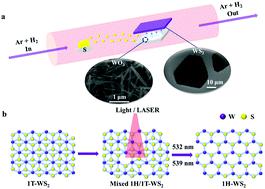当前位置:
X-MOL 学术
›
J. Mater. Chem. C
›
论文详情
Our official English website, www.x-mol.net, welcomes your
feedback! (Note: you will need to create a separate account there.)
Phase selective CVD growth and photoinduced 1T → 1H phase transition in a WS2 monolayer
Journal of Materials Chemistry C ( IF 5.7 ) Pub Date : 2020-06-30 , DOI: 10.1039/d0tc02037k Deepa Thakur 1, 2, 3, 4 , Pawan Kumar 1, 2, 3, 4, 5 , Viswanath Balakrishnan 1, 2, 3, 4
Journal of Materials Chemistry C ( IF 5.7 ) Pub Date : 2020-06-30 , DOI: 10.1039/d0tc02037k Deepa Thakur 1, 2, 3, 4 , Pawan Kumar 1, 2, 3, 4, 5 , Viswanath Balakrishnan 1, 2, 3, 4
Affiliation

|
Phase engineering in 2D materials offers unique opportunities to control polymorphic phases such as 1H, 1T and 1T′ along with their electronic and optical properties to a great extent. We report the direct chemical vapour deposition (CVD) growth of the metastable 1T phase of a WS2 monolayer and the in situ phase transition characteristics with the aid of Raman, Photoluminescence (PL) and fluorescence microscopy (FM). The kinetics of in situ phase transition from 1T to the 1H phase has been directly observed by fluorescence microscopy imaging. Local phase transition has been triggered by directed white light and a laser beam to investigate the kinetics systematically. The process of 1T → 1H phase transformation follows the Johnson–Mehl–Avrami–Kolmogorov (JMAK) model that is normally observed in classical solids under isothermal conditions. The rate constant of light driven phase transformation was calculated to be 1.6 × 10−8 s−1 in the region which follows the JMAK kinetics perfectly. CVD growth of the 1T phase WS2 monolayer and its in situ direct transformation clearly reveal an important aspect of instability and phase transition kinetics. Controlling the stability of the metastable phases and the associated variation in optical properties across phase transition is a key step in realization of optoelectronic applications in rapidly expanding 2D flatland materials.
中文翻译:

WS2单层中的相选择CVD生长和光诱导1T→1H相变
2D材料中的相工程为控制1H,1T和1T'等多态相及其电子和光学性质提供了独特的机会。我们报告了WS 2单层亚稳1T相的直接化学气相沉积(CVD)生长以及借助拉曼光谱,光致发光(PL)和荧光显微镜(FM)的原位相变特性。原位动力学从1T相到1H相的相变已经通过荧光显微镜成像直接观察到。定向白光和激光束已触发局部相变,以系统地研究动力学。1T→1H相变过程遵循Johnson-Mehl-Avrami-Kolmogorov(JMAK)模型,该模型通常在等温条件下的经典固体中观察到。在完全遵循JMAK动力学的区域中,光驱动相变的速率常数经计算为1.6×10 -8 s -1。1T相WS 2单层的CVD生长及其原位直接转化清楚地揭示了不稳定性和相变动力学的重要方面。控制亚稳相的稳定性以及相变过程中光学特性的相关变化,是在快速扩展的2D平地材料中实现光电应用的关键一步。
更新日期:2020-08-06
中文翻译:

WS2单层中的相选择CVD生长和光诱导1T→1H相变
2D材料中的相工程为控制1H,1T和1T'等多态相及其电子和光学性质提供了独特的机会。我们报告了WS 2单层亚稳1T相的直接化学气相沉积(CVD)生长以及借助拉曼光谱,光致发光(PL)和荧光显微镜(FM)的原位相变特性。原位动力学从1T相到1H相的相变已经通过荧光显微镜成像直接观察到。定向白光和激光束已触发局部相变,以系统地研究动力学。1T→1H相变过程遵循Johnson-Mehl-Avrami-Kolmogorov(JMAK)模型,该模型通常在等温条件下的经典固体中观察到。在完全遵循JMAK动力学的区域中,光驱动相变的速率常数经计算为1.6×10 -8 s -1。1T相WS 2单层的CVD生长及其原位直接转化清楚地揭示了不稳定性和相变动力学的重要方面。控制亚稳相的稳定性以及相变过程中光学特性的相关变化,是在快速扩展的2D平地材料中实现光电应用的关键一步。











































 京公网安备 11010802027423号
京公网安备 11010802027423号